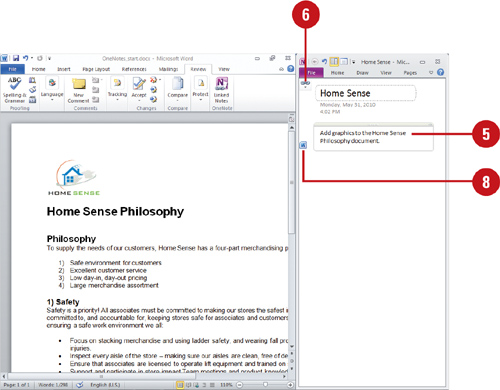Creating a Word Outline from a Presentation
You
can send both your notes and slides to Word so that you can use a full
array of word processing tools. This is especially handy when you are
developing more detailed materials, such as training presentations and
manuals. By default, PowerPoint pastes the presentation into the Word
document. If you change the presentation after sending it to Word, the
changes you make to the presentation are not reflected in the Word
document. If you click the Paste Link option in the Send To Microsoft
Word dialog box, however, you create a link between the Word document
and the presentation, so that changes you make in one are reflected in
the other.
Create a Word Document from a PowerPoint Presentation
 In PowerPoint, click the File tab, click Save & Send, click Create Handouts, and then click the Create Handouts button.
In PowerPoint, click the File tab, click Save & Send, click Create Handouts, and then click the Create Handouts button.

 Click the page layout option you want for handouts.
Click the page layout option you want for handouts.
 To create a link to the presentation, click the Paste Link option.
To create a link to the presentation, click the Paste Link option.
 Click OK.
Click OK.
Word starts, creates a new document, and inserts your presentation slides with the page layout you selected.
 Print the document in Word, editing and saving it as necessary.
Print the document in Word, editing and saving it as necessary.
 When you’re done, click the Close button to quit Word.
When you’re done, click the Close button to quit Word.
Creating and Opening OneNotes
Microsoft
OneNote is a digital notebook program you can use to gather, manage,
and share notes and information. In PowerPoint and Word, you can create
and open notes directly from the Review tab (New!)
by using the Linked Notes button. OneNote auto-links notes to the
Office document you’re viewing, which you can disable or change in the
Advanced section of OneNote Options. You can open a OneNote note by
clicking the Linked Notes button. The Linked Notes button is not
available on the Review tab until you start the program and create an
initial account, which is quick and easy.
Create and Open OneNotes
 Open a document you want to use to create notes.
Open a document you want to use to create notes.

 Click the Review tab.
Click the Review tab.
 Click the Linked Notes button.
Click the Linked Notes button.
 On first document use, select a section or page in which to put the notes, and then click OK.
On first document use, select a section or page in which to put the notes, and then click OK.
 In OneNote, enter the notes you want for the page.
In OneNote, enter the notes you want for the page.

 To work with notes in OneNote, click the Linked Note icon, and then click an option:
To work with notes in OneNote, click the Linked Note icon, and then click an option:
- Linked File(s). Use to select a linked Office document to view.
- Delete Link(s) on This Page. Use to delete links on the current page.
- Linked Notes Options. Select to open OneNote Options.
 When you’re done, click the Linked Note icon in OneNote, and then click Stop Taking Linked Notes. To restart it, click Start Taking Linked Notes on the file tab.
When you’re done, click the Linked Note icon in OneNote, and then click Stop Taking Linked Notes. To restart it, click Start Taking Linked Notes on the file tab.
 To view linked notes, click the Linked Notes button to open OneNotes if needed, point to a note, and then click the Office program icon.
To view linked notes, click the Linked Notes button to open OneNotes if needed, point to a note, and then click the Office program icon.